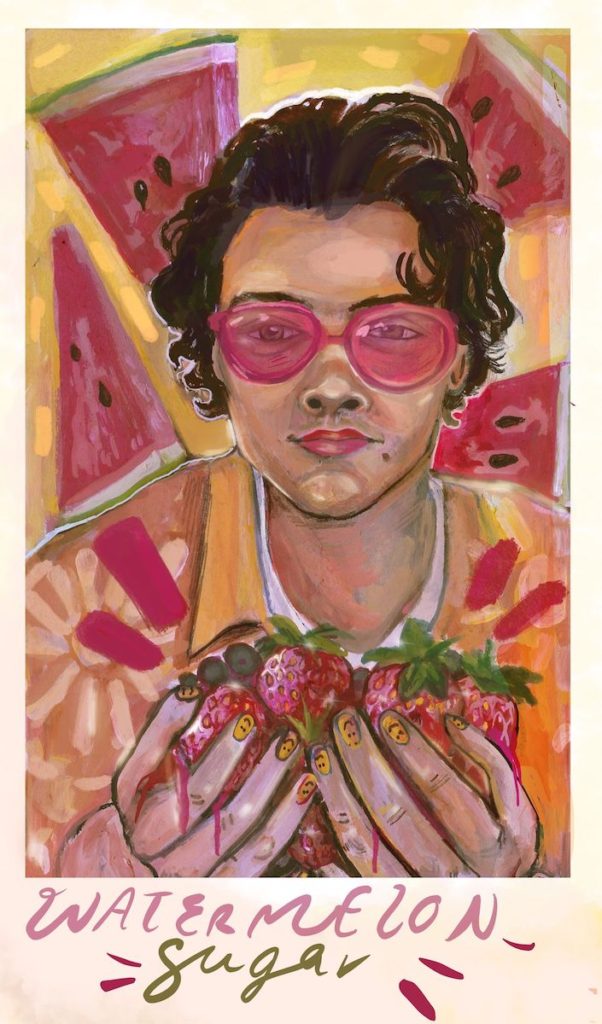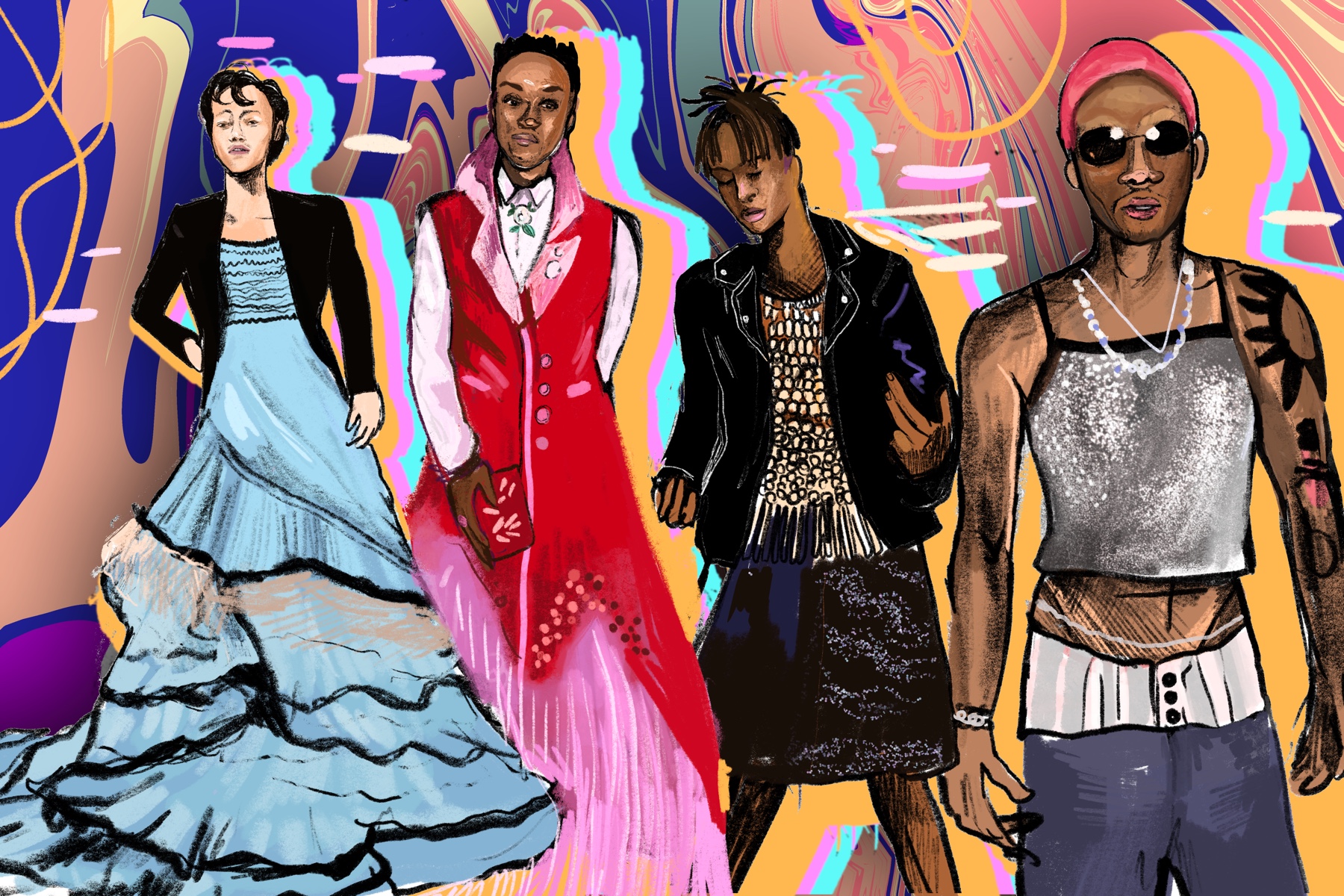On Nov. 13, Grammy-winning artist Harry Styles posted a Vogue magazine cover photo to Instagram of himself wearing a ruffled, blue Gucci dress and black blazer with his iconic monogram rings.
The feedback was mixed. While Styles received positive responses from fans and friends, not everyone was feeling the love—in particular, Candace Owens, a conservative American activist and author.
“There is no society that can survive without strong men. The East knows this. In the West, the steady feminization of our men at the same time that Marxism is being taught to our children is not a coincidence. It is an outright attack. Bring back manly men,” Owens wrote of the cover on Twitter.
A whirlwind of responses surfaced online, reopening the conversation of gender-fluid fashion in mainstream media, every side as passionate as the other. The intense controversy surrounding the cover photo shed light on deeper gender-based issues in Western society.
While other cultures have embraced genderfluid presentation and identities, such as the genderless fashion subculture jenderesu-kei prominent in Japan or First Nations Two-Spirit individuals who carry both male and female spirits, many Westerners are still divided on whether gender presentation should follow binary gender norms.
Both experts in the field and those with lived experience breaking out of gender norms through fashion say the issue of policing how others present gender through their dress is rooted in sexism, homophobia and discrimination.
https://t.co/uf2ZP81TPZ pic.twitter.com/rYbAigFTtX
— Harry Styles. (@Harry_Styles) November 13, 2020
Long-held feminine stigmatization
Allyson Stokes, an assistant professor of sociology at Memorial University in St. John’s, N.L., wrote her thesis on the impact of gender on cultural industries such as fashion.
Stokes said the stigma towards men exploring femininity comes from gendered power dynamics, which value masculinity above femininity.
“If a girl wants to be an engineer, well, it makes sense. Of course you want to go to that instead of a more feminized occupation because you get paid more money and you’ll be learning skills we value more in society,” Stokes said.
“When a man wants to go into fashion … he’s taking a step down.”
Stokes said femininity in men is stigmatized more than women assuming male silhouettes. One example of this is that it is culturally acceptable for women to swap feminine skirts and dresses for traditionally masculine garments such as pants or ‘power suits,’ yet the same is not true for men wearing traditionally-feminine clothing in North America.
Traditionally feminine fashion even boasts products named after their proximity to masculine fashion, such as boyfriend jeans. The ‘tomboy’ style, where feminine people dress in traditionally masculine ways, has become popular in the last few decades.
Leah Morling, an agender first-year Carleton journalism student, said the gender a person is assigned at birth influences the reaction they get when experimenting with their gender presentation.
“I dress for androgyny and since I was assigned female at birth, it’s very different than someone who is assigned male at birth traditionally presenting as more feminine,” Morling said. “There’s a different stigma, so it’s more accepted on my end.”
Morling said they avoid ridicule for their androgynous style of dress by keeping a supportive, close-knit group of friends.

Gender presentation through an LGBTQ+ lens
Stokes said gendered power dynamics are dangerous as some feel entitled to put others into traditional gender norms, sometimes resulting in physical and emotional harm.
“We use fashion and appearance to police people, to judge people and reinforce certain social inequalities,” Stokes said.
Presenting gender beyond the binary can also make some members of LGBTQ+ communities targets of harassment or assault.
According to Statistics Canada, members of LGBTQ+ communities were almost three times more likely to experience some sort of violent victimization than heterosexual people in 2018.
For fear of negative repercussions, those in LGBTQ+ communities can sometimes be afraid to experiment with their style.
Rey Duff, a non-binary first-year Carleton journalism student, said experimenting in a safe and comfortable space, which for some might be at home or with friends, can be a great way to start.
“If you’re scared, you’ll never get to express yourself the way you want to,” he said. “Start by just dressing up at home. Especially [because] we’re in a pandemic, you have all the time in the world to be in this great space.”
Duff said his view of gender is nuanced, and that it is important to acknowledge different perspectives relating to gender.
“I understand that some people identify as binary, but it’s different all around the world and to view it as one strict look—to view it as masculine or feminine—doesn’t make sense to me,” he said.
“Presentation doesn’t equal gender. I think we should view it as a more fluid concept.”
https://twitter.com/image_magazine/status/1099954549983531008
Discrimination and double standards
Despite risks associated with presenting LGBTQ+ identities through fashion, the fashion industry has many prominent LGBTQ+ designers, including Yves Saint Laurent, Alexander McQueen and Harris Reed.
Stokes said part of the reasoning behind the LGBTQ+ community’s historic and continued presence in the fashion industry is due to workplace discrimination.
“Historically in stereotypical masculine jobs, [gay men] were excluded or alienated so these [feminized jobs] were spaces they could actually go into,” Stokes said. “Part of that is because of this conflation we have in our culture, that we conflate homosexuality with femininity.”
A peer-reviewed research paper published in the Journal of Labor Law and the Labor Environment in 2016 reported the way transgender people express their gender identities through dress can contribute to labour market exclusion through a perceived lack of employability.
Although advances in LGBTQ+ fashion may have been paved with difficulty, Morling said LGBTQ+ contributions to fashion have strengthened the community.
“Nothing develops a sense of identity like developing a culture,” Morling said.
While many praise Styles’ Vogue cover photo, some say he isn’t a trailblazer for the gender-fluid movement because his style path was first paved by prominent Black, Indigenous and people of colour fashion icons.
Celebrities such as Prince and Freddie Mercury experimented with their gender presentation in fashion decades ago. More recently, basketball player Dennis Rodman, artists Billy Porter and Jaden Smith, and rapper A$AP Rocky are all prominent examples of those using feminine fashion as a means of self-expression.
While Morling said no one is free from suffering the potential backlash that accompanies subverting gender norms in fashion, celebrities have the privilege that comes along with fame.
“Because they’re famous and you know who they are, there’s a baseline of respect,” Morling said. “If you see someone on the street you have so many preconceptions about them, but when you see someone who’s famous, you know something about them. They feel more valid. It’s kind of a double standard.”

The best is yet to come
The Council of Fashion Designers of America partnered with Glamour magazine to conduct their own internal investigation of the gender dynamics of the industry in 2018.
The survey, the Glass Runway, found 100 per cent of the women surveyed saw gender equality as an issue in fashion, while less than 50 per cent of men did. The study also found while the industry caters to women as consumers, fewer women were in high-standing positions.
While gender-related issues have plagued the fashion industry for decades, Stokes said she thinks there has been some progress in the global conversation about gender fluidity in fashion and is seeing an increasing number of people embracing their identities through what they wear.
“It’s also kind of fun to play with gender through fashion, so it’s not surprising to me that more and more designers and shows would be presenting more genderless fashion and putting it on a variety of different models,” Stokes said.
“It’s kind of hard for the fashion industry to ignore where our culture is going.”
Featured graphic by Sara Mizannojehdehi.






